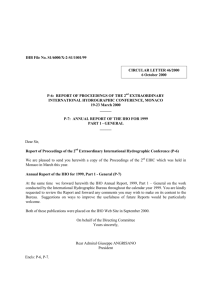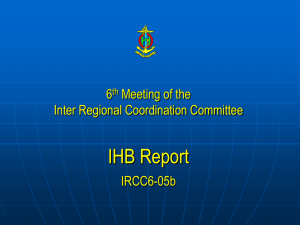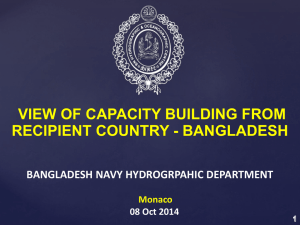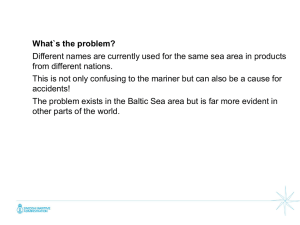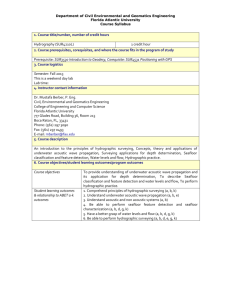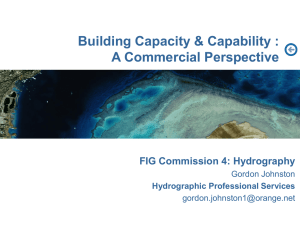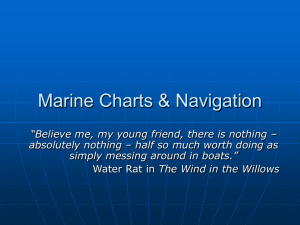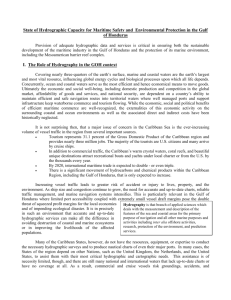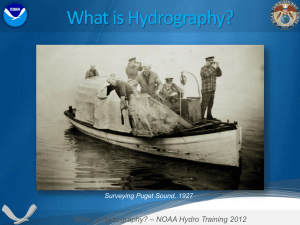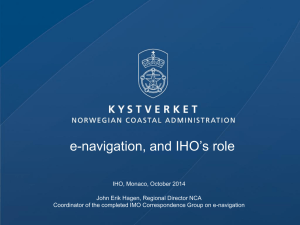Hydrographic Services
advertisement
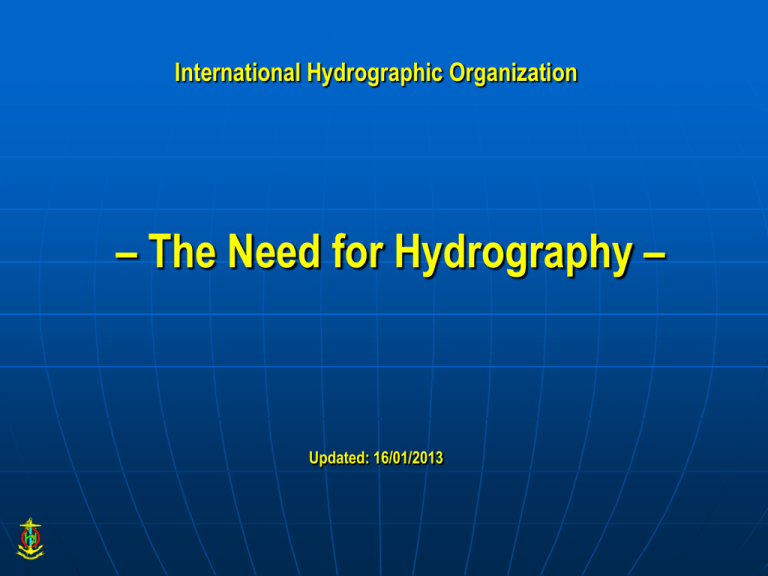
International Hydrographic Organization – The Need for Hydrography – Updated: 16/01/2013 IHO definition: the measurement and description of the physical features of oceans, seas, coastal areas, lakes and rivers, …. …. for the primary purpose of safety of navigation and in support of all other marine activities, including economic development, security and defence, scientific research, and environmental protection Hydrography provides the fundamental backdrop for almost everything that happens in, on or under the sea … without hydrography - no ship sails … without hydrography - no port is built … without hydrography - no offshore infrastructure is developed … without hydrography - no environmental plan is implemented … without hydrography - no shore is defended, no island protected … without hydrography - no rescue is attempted … without hydrography - no maritime boundary is delimited Hydrography supports : Safety of navigation Protection of marine environment National infrastructure development Coastal zone management Marine exploration Resource exploitation – minerals, fishing Maritime boundary delimitation (UNCLOS, others) Maritime defence and security Disaster management Inadequate hydrography means: • risk of marine accidents increases – environmental pollution – loss of life • shipping lacks confidence in ports and routes • international trade is limited • missed economic opportunities • environmental impacts • potential liability and litigation what is the cost of: • under-developed ports? • using complex and hazardous shipping routes? • lack of fundamental planning data for the coast and seas? • imprecise disaster planning models? • limited sea room for patrol vessels? Cost versus Benefit Studies Australia (1992) Canada (1992) APEC (2002) different analysis approaches: • “ what would happen if the charts weren’t there ?” • “ what if no further hydrography took place ?” Cost vs Benefit ratios greater than1:10 ! – Hydrographic Services – International Obligations Mariners’ Obligations Convention on the Safety of Life at Sea (SOLAS) Chapter V SOLAS V/19 – Carriage requirements for Nav equipment • • …shall carry nautical charts and publications … • … [adhering to] IHO specifications and guidelines …issued officially by or on the authority of a Government, authorized Hydrographic Office or other relevant government institution …. SOLAS V/27 – Nautical charts and nautical publications • …adequate and up to date Governmental Obligations SOLAS V/9 – provision of hydrographic services • Contracting governments undertake to arrange to collect and compile hydrographic data, and to publish, disseminate and update all nautical information necessary for safe navigation; • Obtain uniformity in charts and nautical publications and to take into account whenever possible the relevant international resolutions and recommendations, adopted by the IHO; and • Co-ordinate activities and ensure global availability of hydrographic and nautical information Governmental Obligations SOLAS V/4 – navigational warnings …take all steps necessary to ensure that, when intelligence of any dangers is received from whatever reliable source, it shall be promptly brought to the knowledge of those concerned and communicated to other interested Governments SOLAS Chapter 5 regulations 9 and 4 This means each State must ensure that : • hydrographic surveys are carried out • appropriate nautical charts and other nautical publications are available and up to date • Maritime Safety Information (MSI) is promulgated SOLAS V/9, SOLAS V/4 (provision of hydrographic services and navigational warnings) … are International Obligations under Treaty Law … apply to ALL Contracting Governments Other Governmental Obligations • UN Resolution A.53/32 - The Year of the Oceans ….. invites States to cooperate in carrying out hydrographic surveys and in providing nautical services for the purpose of ensuring safe navigation as well as to ensure the greatest uniformity in charts and nautical publications and to coordinate their activities so that hydrography and nautical information is available on a world-wide scale UNCLOS 1982 Charts are required to support: • Establishing baselines • Delimiting Sea Areas –Territorial Sea, EEZ ,Continental Shelf , etc • Identifying traffic separation schemes • Identifying sea lanes transit and innocent passage routes • Deploying submarine cables and pipelines • Conducting drilling on the seafloor • Conduct of Marine Scientific Research Meeting Governmental Obligations SOLAS V/9 and V/4 can be satisfied: • directly via government • through bi-lateral cooperation with other States • using commercial support providers - in whole or in part Overall responsibility and obligation to ensure that a national hydrographic service is provided remains with the Government - Role of the IHO - IHO • intergovernmental consultative and technical organization • established in 1921 • to support safety of navigation and the protection of the marine environment IHO Mission … to facilitate the provision of adequate and timely hydrographic information … for world-wide marine navigation and other purposes … through the co-ordination of the endeavours of national hydrographic offices History 1908 1912 1919 1921 1970 2005 2012 International Congress of Navigation, St Petersburg International Maritime Conference, St Petersburg International Hydrographic Conference, London IHB established by 24 nations in Monaco International Convention: established Protocol of Amendments to the IHO Convention …awaiting majority of Member States’ approval to amendments IHO Member States – 2013 ALGERIA ARGENTINA AUSTRALIA BAHRAIN BANGLADESH BELGIUM BRAZIL CAMEROON CANADA CHILE CHINA COLOMBIA CROATIA CUBA CYPRUS DEMOCRATIC PEOPLE’S REPUBLIC OF KOREA DEMOCRATIC REPUBLIC OF THE CONGO DENMARK DOMINICAN REPUBLIC ECUADOR EGYPT ESTONIA FIJI FINLAND FRANCE GERMANY GREECE GUATEMALA ICELAND INDIA INDONESIA IRAN (ISLAMIC REPUBLIC OF) IRELAND ITALY JAMAICA JAPAN KUWAIT LATVIA MALAYSIA MAURITIUS MEXICO MONACO MOROCCO MOZAMBIQUE MYANMAR NETHERLANDS NEW ZEALAND NIGERIA NORWAY OMAN PAKISTAN PAPUA NEW GUINEA PERU PHILIPPINES POLAND PORTUGAL QATAR REPUBLIC OF KOREA ROMANIA RUSSIAN FEDERATION SAUDI ARABIA SERBIA SINGAPORE SLOVENIA SOUTH AFRICA SPAIN SRI LANKA SURINAME SWEDEN SYRIAN ARAB REPUBLIC THAILAND TONGA TRINIDAD AND TOBAGO TUNISIA TURKEY UKRAINE UNITED ARAB EMIRATES UNITED KINGDOM OF GREAT BRITAIN AND NORTHERN IRELAND URUGUAY UNITED STATES OF AMERICA VENEZUELA (BOLIVARIAN REPUBLIC OF) Awaiting Approval: BULGARIA HAITI MAURITANIA MONTENEGRO SIERRA LEONE BRUNEI DARUSSALAM GEORGIA VIET NAM IHO Member States – 2013 International Hydrographic Bureau IHO Secretariat 19 Personnel • • • • 3 Directors 5 Assistant Directors 2 + 1 Translators 8 Supporting Staff INTERNATIONAL HYDROGRAPHIC BUREAU INTERNATIONAL HYDROGRAPHIC CONFERENCE Finance Committee (FC) WGs as required Hydrographic Services and Standards Committee (HSSC) Inter-Regional Coordination Committee (IRCC) Regional Hydrographic Commissions Technical Working Program other WGs as required Capacity Building Sub-Committee Regional Coordination other WGs as required International Hydrographic Bureau Secretariat 15 technical standards 10 associated guidelines 18 other publications Direct support to 40 bodies (Committees, WGs and RHCs) Conference organisation External representation bi-lingual website IHO Decision Making Committees and WGs only provide proposals Unless decided at a Conference • ALL Member States are consulted simple majority required for technical decisions 2/3 majority required for other matters • Not responding, is in effect = “NO” Normal procedure for many inter-governmental organizations Regional Hydrographic Commissions regional co-ordination of • • • • • • nautical information hydrographic surveys production of nautical charts and documents training technical cooperation hydrographic capacity building projects Regional Hydrographic Commissions Governed by Statutes - NOT IHO regulations – IHO Capacity Building – Capacity Building Sub Committee Objectives: continuously assess hydrographic surveying, nautical charting and nautical information status in nations and regions where hydrography is developing establish and maintain close relationships with national agencies and international organizations, to identify funding and technical assistance cooperate with Regional Hydrographic Commissions Capacity Building Strategy Awareness Raise priority of Hydrography Assessment Identify and prioritize problems Analysis Identify Projects based on national/regional priorities Action Implementation of Activities. Follow-up Phases of Hydrographic Capacity Building Preliminary • Raise awareness Phase One • Collection and circulation of nautical information needed to maintain existing charts and publications Phase Two • Capacity to conduct hydrographic surveys, data gathering and processing Phase Three • Production of charts and publications IHO Capacity Building Fund Fund supports: • • • • • Technical Assistance Training and Education Financial Assistance Start-up Projects Proposals submitted via Regional Hydrographic Commissions – Conclusion – Benefits of IHO Membership Develop the national hydrographic service Improve safety of navigation Increase wealth from the sea and ocean Gain access to capacity building support Access regional and bi-lateral cooperation programmes International Hydrographic Organization International Hydrographic Bureau 4 b, Quai Antoine 1er B.P. 445 MC 98011 MONACO CEDEX Principauté de Monaco Telephone: +377 93 10 81 00 Fax: +377 93 10 81 40 e-mail: info@iho.int WEB Site: http://www.iho.int
